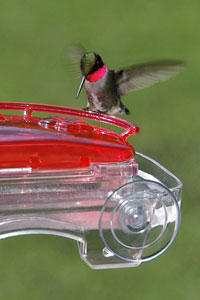Hummingbirds Everywhere!
We've now hit peak hummingbird season, and for the next few weeks you will see these tiny birds' huge personalities on full display. It's time for the hummingbird wars!
For such a little bird, hummingbirds can be very feisty and aggressive when defending their territories; which includes nectar feeders. Multiple feeders, spread throughout your yard, will encourage more hummingbirds to visit and keep bullies at bay. We recommend a distance of about 25 feet to avoid allowing a single bird to dominate.
Speaking of feeders, these little birds have big appetites. Hummingbirds eat about every ten minutes and their diet is not made up entirely of nectar. They spend more than 25% of their time foraging for small spiders and insects to obtain essential amino acids and other nutrients.
Hummingbirds use their bill and not their tongue to catch prey while they forage near the ground and in trees. They love spiders and spider eggs and keep an eye out for small flying insects like midges, fruit flies and gnats. They also check leaves and branches for leaf hoppers, aphids and even the occasional small caterpillar.
Hummingbirds are indeed small, weighing 1/10th of an ounce; about the weight of a penny. They also lay the world’s smallest bird egg; about the size of a blueberry.
Our little hummingbirds are deceptively big on speed. They often seem to explode away from a feeder like a dragster. They typically fly at 30-45 miles per hour (48-72 kph), but can fly up to 60 mph (96 kph). They can even hover and are the only birds able to regularly fly backwards and even occasionally upside down. They can do this because of an extremely mobile shoulder joint.
Be a seasonally savvy bird feeder by installing a hummingbird feeder to draw in these little birds with the big personalities. Visit our store and we'll help you pick out everything you need to attract hummingbirds to your backyard.


